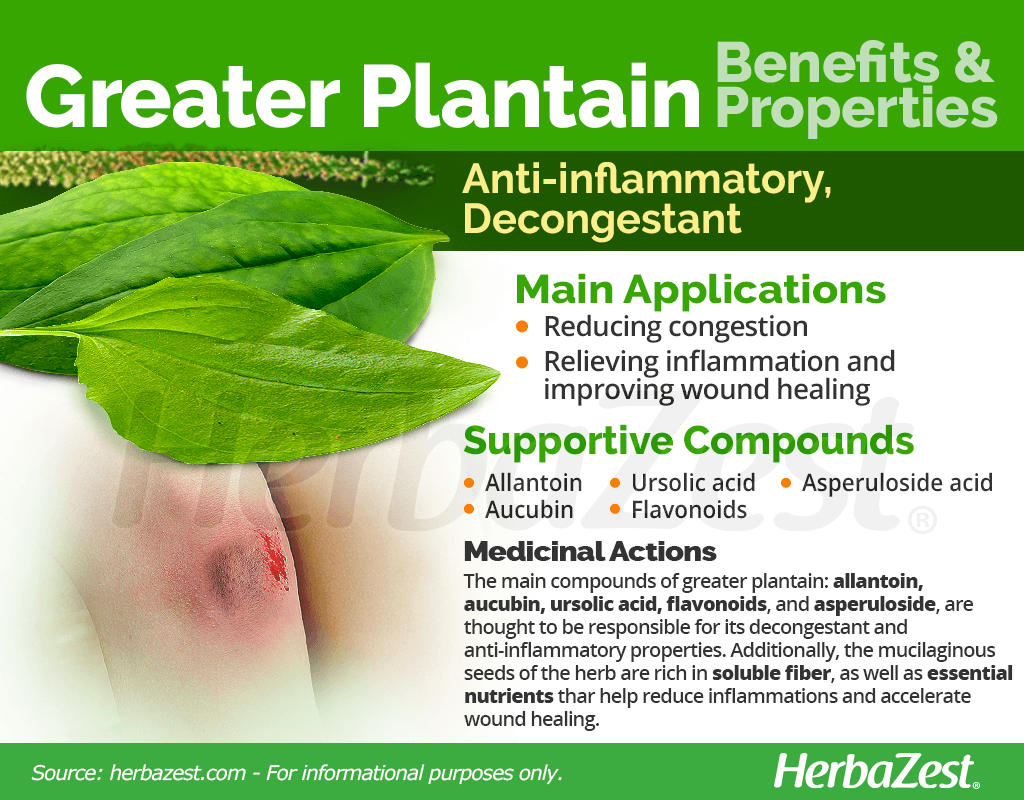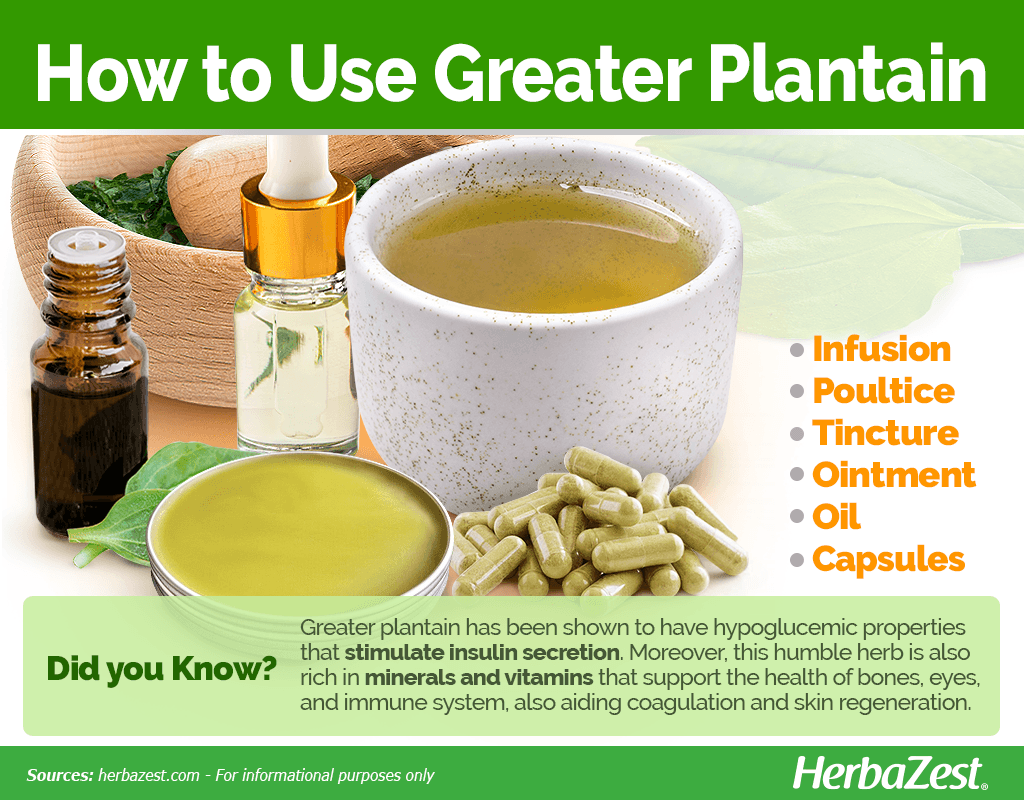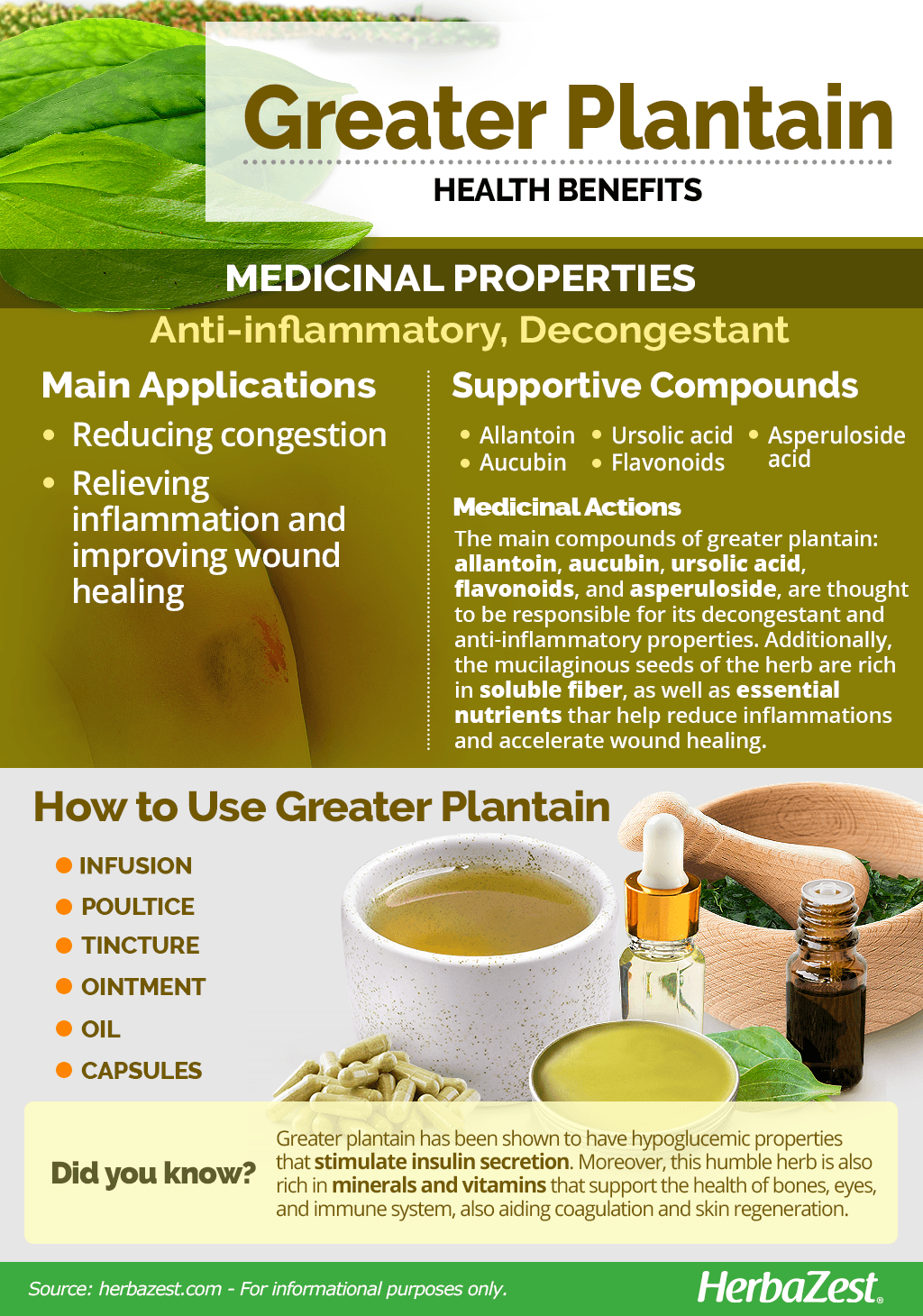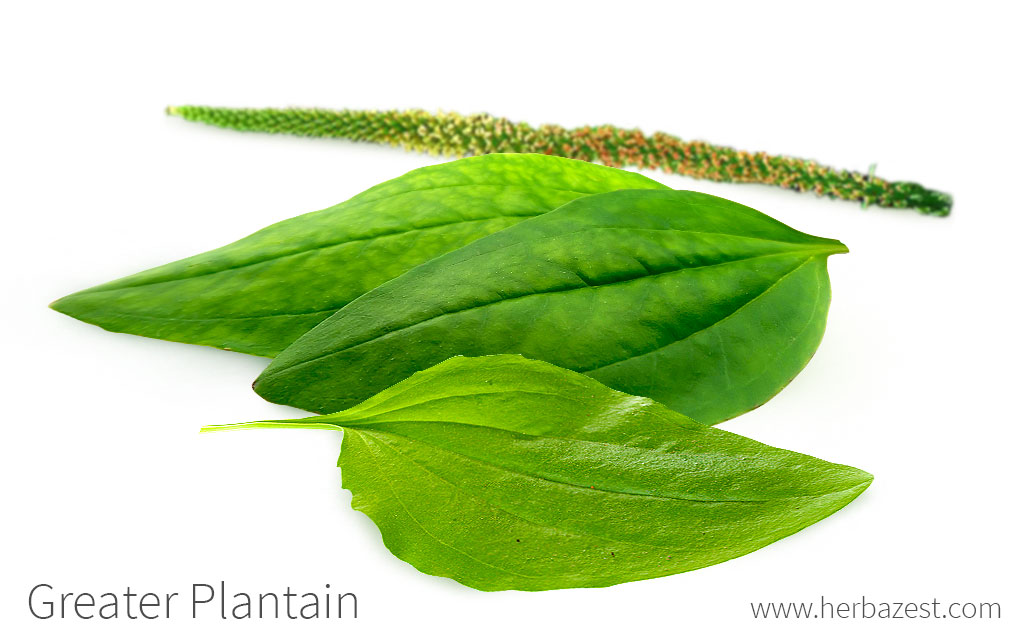Greater plantain – also known as common plantain, plantago, and wide leaf plantain, among other names- is a weed that has been traced back to Nordic Europe, around 4,000 years ago. In the Scandinavian region, Plantago major is commonly known as groblad, meaning "healing leaves." References to its healing qualities can be found in early texts, including Dioscorides' De Materia Medica and Shakespeare's Romeo and Juliet, both of which talk about the herb as a way of repairing an open wound. The plant is still valued today in Chinese and alternative Western medicine.
Greater Plantain Medicinal Properties
Health Benefits of Greater Plantain
Originally, people used the leaves from the greater plantain plant as an anti-inflammatory agent and applied it to open wounds to encourage broken skin to mend. Extensive research has since been carried out and revealed that it boasts many other medicinal properties, too. The most remarkable benefits of greater plantain are:
Reducing congestion. It is thought that consumption of the herb in the form of tea can assist in the reduction of mucus and inflammation in the throat.
Relieving inflammation and improving wound healing. Greater plantain leaves can be applied to wounds, rashes, bites, and stings to soothe the affected area and accelerate cauterization.
How It Works
The main compounds of greater plantain are allantoin, aucubin, ursolic acid, flavonoids, and asperuloside, which are thought to be responsible for its mucolytic and anti-inflammatory properties.1 The seeds are also mucilaginous, which means they are rich in soluble fiber.
Both the leaves and seeds of the herb are rich in in minerals, such as calcium, zinc, and potassium, as well as vitamins A (from carotenoids), C (ascorbic acid), and K. These important nutrients help keep bones and teeth strong, support eye health, boost immune system activity, and aid coagulation, allowing faster wound healing.2
A study has shown that greater plantain exerts hypoglycemic properties by stimulating the secretion of insulin.3
Other well-known decongestant herbs are osha and eucalyptus, whereas anti-inflammatory and wound healing properties can be found in aloe, gotu kola, and mashua.
Greater Plantain Side Effects
Greater plantain is thought to be safe for external and internal use for adults and children, unless the user suffers from relevant allergies. It has been reported in the U.S. and Switzerland that some adulterated greater plantain products have caused dangerous side effects, so caution should be practiced to ensure that the seller or producer is reputable.
Greater Plantain Cautions
If the greater plantain is to be ingested, please note it may affect the absorption of other medications. It is recommended to consume the herb with water.
It is also worth noting that sufferers of severe hay fever may be affected by greater plantain. It is advisable to check with a doctor before consumption of any herb, particularly those who are pregnant or breastfeeding.
- Medicinal action Anti-inflammatory, Decongestant
- Key constituents Allantoin, aucubin, ursolic acid, flavonoids, and asperuloside
- Ways to use Capsules, Hot infusions/tisanes, Food, Tincture, Poultice, Ointment, Dried
- Medicinal rating (3) Reasonably useful plant
- Safety ranking Safe

How to Consume Greater Plantain
Greater plantain is a fairly common weed, which can be easily grown and picked for household use. Its leaves can be enjoyed in a salad. Simply wash and consume them raw as an efficient and tasty way to reap its many health benefits. This raw form is particularly recommended as a way to quickly absorb the nutrients that greater plantain has to offer.
Medicinal preparations are made from the leaves and seeds of greater plantain, but they can also be bought in various concentrated forms, which are more medicinally effective for treating specific conditions.
Natural Forms
Infusion. Greater plantain is most commonly consumed as an herbal tea. It can be made using the Plantago major leaf or teabags that are available to buy.
Poultice. This home remedy is made by crushing the leaves and seeds of the herb into a pulp, and applying it directly to a wound or irritated area. Its anti-inflammatory properties will relieve the pain and enhance the healing process. The poultice can be secured with a gauze, wrapped around if necessary.
Herbal Remedies & Supplements
Tincture. This concentrated solution is another popular form of reaping the benefits of greater plantain by diluting a few drops into a glass of water for drinking, or pour a few drops onto a cotton pad for topical use to soothe the skin.
Ointment. This can be applied to skin to encourage wound healing, reduce redness and swelling caused by bites and stings, as well as soothe skin irritations and rashes.
Oil. An oil of greater plantain can be used topically on problematic skin areas or insects bites. It is also considered to be a quality moisturizer.
Capsules. Greater plantain capsules are valued as a practical way of ingesting the herb for treating bronchial and respiratory problems.
- Edible parts Flowers, Leaves, Seed, Stem
- Edible uses Flavoring, Beverage

Growing
Greater plantain is a natural weed, and many consider it invasive and a nuisance. When wet, the mucilaginous seeds become adhesive, which means they can be distributed easily as a way to spread the herb. Greater plantain is a self-fertilizing plant that is easy to grow and requires little attention. It grows to approximately six inches (15 cm) high.
Growing Guidelines
- Since greater plantain is a hardy plant, it can survive many different environments, including compacted soil and areas of drought, as well as areas with excess water.
- In a warm environment, the plantago plant may flower throughout all seasons; however, in colder climates, it will usually flower between May and September only.
- After planting, greater plantain takes approximately 90 days before flowering, weather permitting.
- Growth is encouraged in compacted soil; for instance, in grasslands, the tread of livestock aids the plant. At home, regular lawn mowing and general use of the garden will be beneficial.
- In well-established plants, the rosette of plantago leaves will be produced annually. These will die and retract back to the roots in cold weather.
Detailed information about growing greater plantain can be found in the herb garden section.
- Life cycle Perennial
- Harvested parts Flowers, Seeds, Leaves, Stem
- Light requirements Full sun, Partial shade
- Soil Loamy sand, Well-drained
- Soil pH 6.6 – 7.3 (Neutral)
- Pre-germination seed treatment None
- Plant spacing average 0.3 m (0.98 ft)
- Growing time 8 - 15 weeks
- Potential insect pests Aphids
- Potential diseases Cucumber mosaic virus
- Potential animal pests Birds
Additional Information
Plant Biology
Greater plantain is a common weed that occurs across the globe in a range of environments. It is a short, perennial plant that consists of a rosette of dark green leaves averaging around two by five inches (5 x 13 cm) in size. These are usually smooth or have short hairs on them. Protruding from the center of the leaves is a relatively thick stalk that grows to a thicker cylindrical shape with small yellow-green flowers. These will eventually go brown and dry, and a small capsule is produced below each one. This contains 6 - 30 small, black or brown seeds.
Classification
Greater plantain is part of the Plantaginaceae family, which consists of around 1,700 accepted species of flowering plants across 110 genera, including other species of plantain, which are also widespread and commonly known. Another medicinally important herb in the Plantaginaceae family is turtlehead (Chelone glabra).
Related Species
The other well-known species of the genus Plantago include P. lanceolata, P. media, P. maritima, and P. coronopus. P. lanceolata is considered to be another nuisance weed, which is particularly abundant in the U.K. P. media is more aesthetically pleasing and is, therefore, thought of as a wild flower. P. maritima is a weed that grows close to the sea and on cliffs, while P. coronopus is another hardy plant that boasts several medicinal remedies not dissimilar to those of P. major.
Historical Information
As mentioned, greater plantain originated in Nordic Europe. Europeans introduced the plant across the world, and it became known among Native American Indians as "white man's footprint," as they said the flower began to grow wherever the Europeans had trodden.
The scientific name of the genus, Plantago, is derived from the Latin word planta, which means "sole of the foot."
Economic Data
The general opinion is that greater plantain is a weed, and the fact that it can be grown easily in most climes and conditions means that this medicinal herb is not widely imported or exported. Supplements are largely produced in the U.S. and Europe - particularly the U.K. and Switzerland.
Other Uses
The greater plantain is mostly valued for medicinal purposes, but its properties can be utilized in other ways. For example, due to the mucilaginous quality of the seeds, the pulp of the plant can be used as an effective cleaning agent on delicate areas.
Greater plantain is often regarded as merely a nuisance weed, and therefore, its medicinal properties are not taken advantage of. This is unfortunate as it has a lot to offer, and it is easy to prepare the teas and solutions required to use the herb for health benefits.
- Other uses Cleaning
Sources
- Database of Academic Research Journals, World Journals, Plantaginaceae
- Garden Organic, Greater Plantain
- Hyperlipidaemia 3Ed: Diagnosis and Management, pp. 235
- Indian Herbal Remedies, Rational Western Therapy, Ayurvedic and Other Traditional Usage, Botany p. 347
- Natural Medicine First Aid Remedies, Self-care treatments for 100+ common conditions pp. 37- 271
- North Carolina State University, Cooperative Extension, Plantago Major
- The Dictionary of Alternative & Complementary Medicine
- University of Michigan Health, Plantain
- Utah State University, Extension, Broadleaf plantain
- Journal of Ethnopharmacology, The traditional uses, chemical constituents and biological activities of Plantago major L. A review, 2000
Footnotes:
- Avicenna Journal of Phytomedicine. (2013). Histophatologic changes of lung in asthmatic male rats treated with hydro-alcoholic extract of Plantago major and theophylline. Retrieved February 10, 2023, from: https://www.ncbi.nlm.nih.gov/pmc/articles/PMC4075699/
- World Journal of Plastic Surgery. (2019). The Healing Effect of Plantago Major and Aloe Vera Mixture in Excisional Full Thickness Skin Wounds: Stereological Study. Retrieved February 10, 2023, from: https://www.ncbi.nlm.nih.gov/pmc/articles/PMC6409144/
- Medicinal & aromatic plants (Los Angeles, Calif.). (2017). Hypoglycemic Effect due to Insulin Stimulation with Plantago major in Wistar Rats. Retrieved February 10, 2023, from: https://www.ncbi.nlm.nih.gov/pmc/articles/PMC6738971/





